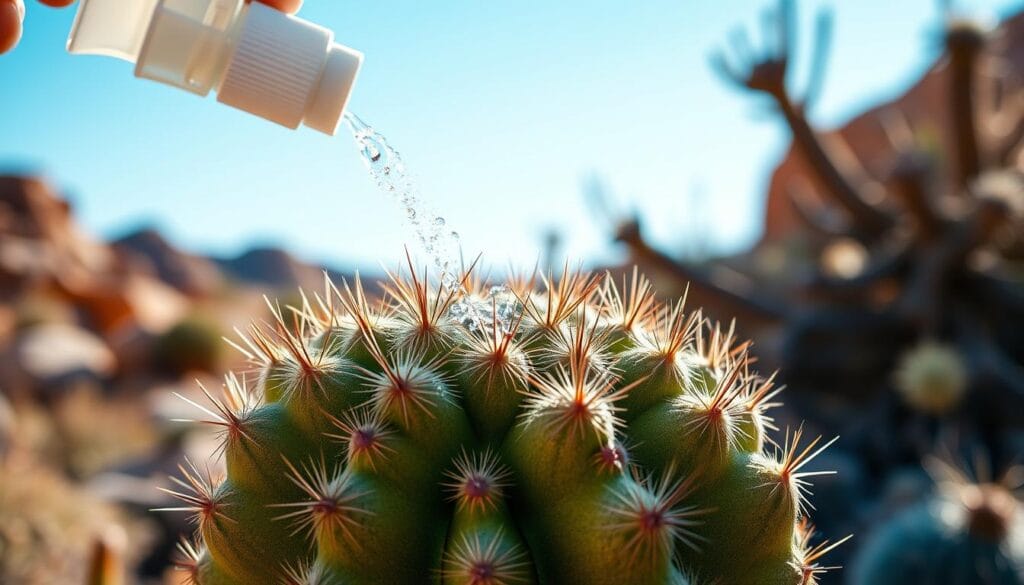Did you know the Bunny Ears Cactus can take up to 20 years to grow to its full height1? It’s a slow-growing beauty that’s loved for its unique look and easy care. I’m excited to share my tips on how to care for this cute succulent.
The Bunny Ears Cactus comes from Northern Mexico. It can grow up to 3 feet tall and 5 feet wide21. Its flat, oval pads covered in white glochids look like bunny ears. But, those tiny glochids can cause irritation if not handled carefully.
In spring and summer, the Bunny Ears Cactus blooms with beautiful, creamy yellow flowers1. These flowers can turn into red or purple fruits, adding color to the plant. It’s a great choice for those who don’t have a lot of time to care for plants.
This cactus thrives in USDA Hardiness Zones 9-11, preferring temperatures between 65°F and 85°F21. It loves the sun but can handle partial shade. Its slow growth and low watering needs make it perfect for those looking for a long-lasting, easy-to-care-for plant.
Key Takeaways
- Bunny Ears Cactus is a slow-growing, low-maintenance succulent
- Native to Northern Mexico, it can grow up to 3 feet tall and 5 feet wide
- Produces creamy yellow flowers in spring and summer
- Thrives in full sun to partial shade
- Prefers temperatures between 65°F and 85°F
- Ideal for USDA Hardiness Zones 9-11
- Requires minimal watering and well-draining soil
Introduction to Bunny Ears Cactus (Opuntia microdasys)
I’m excited to introduce you to the Bunny Ears Cactus. It’s a unique plant that has won the hearts of many. This cactus grows slowly and can get up to 3 feet tall and 6 feet wide3. It’s loved for its looks and how easy it is to care for.
Origin and Native Habitat
The Bunny Ears Cactus comes from northern Mexico’s dry areas. It does well in zones 9, 10, and 11, showing it loves warm places3. It’s now found in gardens all over, including Australia, where it’s grown for its beauty4.
Unique Characteristics and Appearance
The Bunny Ears Cactus stands out because of its pad-like shape. These pads look like rabbit ears, which is why it’s called that. They start bright green and turn pale green as they get older4.
Instead of sharp spines, the pads have tiny, fuzzy glochids. This makes the plant feel soft and velvety.
Common Names and Varieties
This cactus is also known as the angel’s wings cactus and polka-dot cactus. It looks different from the Mexican fence post cactus, which grows tall4. There are special versions like Opuntia microdasys form monstrosa, showing how versatile it is4.
The Bunny Ears Cactus has beautiful yellow flowers with a red edge. These flowers are 3-5 cm wide and bloom in spring and summer. After that, it produces red to purple fruits about 3 cm wide34. It’s great for those who want a plant that’s easy to care for but looks amazing.
Ideal Growing Conditions for Bunny Ears Cactus
I love how the Bunny Ears Cactus thrives in warm, dry environments. It’s perfect for both indoor cacti fans and outdoor gardeners in the right climates. This cactus can grow up to 3 feet tall and 5 feet wide, living for 30 years or more56.
For it to grow well, I make sure it gets lots of sunlight. It loves full sun, getting 6-8 hours of direct sunlight every day. Indoors, I put it near a south or west-facing window to match its natural home.
Temperature-wise, this cactus does best in warm spots. I keep its temperature between 65°F to 85°F for the best growth5. It’s important to keep it away from drafts and sudden temperature changes. It can even handle temperatures as low as 25°F, making it good for USDA hardiness zones 7-106.
Humidity is also key. I’ve found that a moderate humidity level of 30% to 50% is best for this desert native5. This low humidity makes it great for indoor spaces where the air can be dry.
Like many drought-tolerant plants, the Bunny Ears Cactus needs little water. But, if you’re starting new plants, more water in the first year helps the roots grow strong5. Remember, too much water can harm these tough cacti more than too little.
Soil Requirements and Potting Mix
To grow your Bunny Ears Cactus right, you need the perfect soil. I’ll show you the best soil mix, a DIY recipe, and why pH levels and drainage matter.
Best Soil Composition
Bunny Ears Cactus loves sandy, well-draining soil like its desert home. The best mix has low water-holding to avoid root rot. You can buy a cactus mix or make your own.
DIY Potting Mix Recipe
Here’s a simple recipe for a homemade cactus potting mix:
- 1 part regular potting soil
- 1 part coarse sand
- 1 part perlite or pumice
Mix these well to get a soil that drains well but holds some moisture for your cactus.
pH Levels and Drainage Importance
The pH of your soil is key for nutrient uptake. Bunny Ears Cactus likes slightly acidic to neutral soil, with a pH of 6.1 to 7.8. Good drainage stops water from causing root rot.
Remember, this cactus can grow big, up to 3 feet tall and 5 feet wide. Choose a big enough pot for it to grow7. Repot it every one or two years in a slightly larger pot7. With proper care, your cactus will flourish, covering 2 to 5 feet of ground as it grows8.
Watering Techniques for Optimal Growth
Learning how to water your Bunny Ears Cactus is key. It’s a top pick for those who forget to water or want to save water. This desert plant loves dry conditions.
In spring and summer, I water my Bunny Ears every 1-2 weeks9. As fall comes, I water once every 3-4 weeks9. This lets the soil dry out fully, just like in its natural home.

| Season | Watering Frequency | Amount |
|---|---|---|
| Spring/Summer | Every 1-2 weeks | Thorough soaking |
| Fall/Winter | Every 3-4 weeks | Light watering |
Don’t overwater your Bunny Ears Cactus. Always check the soil moisture before you water. If it’s still damp, wait a bit longer. This method has helped my plants grow tall and wide9.
“Water deeply but infrequently. It’s better to underwater than overwater a Bunny Ears Cactus.”
By using these watering tips, your Bunny Ears Cactus will grow well. It will be a beautiful, easy-to-care-for plant in your garden or home.
Light and Temperature Preferences
Bunny Ears Cactus loves bright spots, making it great for sunny areas. It needs at least 6 hours of direct sunlight outside10. Morning sun is kinder than the strong afternoon sun10.
Sunlight Exposure Needs
Bunny Ears Cactus does well in full sun to partial shade. It’s flexible and can adjust to various light levels. A mix of direct sunlight and shade during the hottest hours works best.
Indoor vs. Outdoor Lighting
For indoor growth, a south-facing window is perfect10. If light is scarce, LED grow lights are a good substitute. I keep these lights a few feet away to avoid overheating10. For flowers, it needs up to 14 hours of darkness10.
Temperature Tolerance and Ideal Range
Bunny Ears Cactus likes warm temperatures between 70-85°F (21-29°C)11. It can handle even hotter weather11. It thrives in USDA zones 9 to 1112. In cooler months, I water it less, once a month or less, to match its slower growth11.
While it loves heat and sun, protect it from extreme temperature changes. This can cause brown spots12. With the right light and temperature, your Bunny Ears Cactus will grow well. It can reach up to 3 feet tall and 5 feet wide in about 20 years12.
Propagation Methods for Bunny Ears Cactus
I love sharing my experience with cactus propagation, especially with the Bunny Ears Cactus. Spring and early summer are the best times for this. The conditions are just right for cuttings to grow well13. Let’s look at the two main methods: pad cuttings and seeds.

Pad cuttings are my favorite method. I remove a mature pad and let it dry for a day. This step is key to prevent rot. Then, I plant it in well-draining soil, burying it about an inch deep14. Water it sparingly until roots grow. These cacti grow best in temperatures between 65°F and 85°F14.
Seed propagation is a bit harder but very rewarding. I sow the tiny seeds on top of cactus potting mix, keeping it warm and a bit moist. It takes a lot of patience – it can take up to 20 years for a Bunny Ears Cactus to grow tall14!
| Propagation Method | Difficulty | Time to Maturity |
|---|---|---|
| Pad Cuttings | Easy | 1-2 years |
| Seeds | Challenging | Up to 20 years |
Choose your method wisely. Avoid propagating during flowering. The plant’s energy is focused elsewhere, making success rates lower13. With the right care, your new Bunny Ears Cactus will flourish. It might even reward you with beautiful 2-inch long fruits in red or purple14.
Pruning and Maintenance Tips
Caring for a Bunny Ears Cactus is easy with regular maintenance and repotting. I’ll show you how to keep your cactus happy and healthy.
When and How to Prune
Spring is the best time to prune your Bunny Ears Cactus. I remove skinny or damaged pads to help it grow better. Trimming the tips encourages more branches, making the plant fuller. Remember, this cactus can grow up to 3 feet tall and 5 feet wide, so pruning keeps it in shape15.
Cleaning and Pest Prevention
Keeping your cactus clean is key. I use a soft brush to wipe off dust and check for pests. Bunny Ears Cacti have glochids that can irritate skin, so I always wear gloves15.
Repotting Guidelines
Repotting your cactus is important for its growth. I repot my Bunny Ears Cactus every 1 to 2 years in spring, using a slightly larger pot15. Here’s how I do it:
- Prepare a well-draining cactus soil mix
- Gently remove the cactus using gloves or tongs
- Inspect and trim any damaged roots
- Place in the new pot and fill with fresh soil
- Wait a week before watering to allow for recovery
To help your Bunny Ears Cactus grow well, make sure it gets at least 6 hours of sunlight daily. Keep the temperature between 65°F to 85°F indoors1615. With the right care, this tough plant can live for many years, adding a special touch to any room.
| Maintenance Task | Frequency | Best Season |
|---|---|---|
| Pruning | Annually | Spring |
| Cleaning | Monthly | Year-round |
| Repotting | Every 1-2 years | Spring |
Common Pests and Diseases
Bunny Ears Cactus faces some common problems. Mealybugs and scale insects are big pests. They can harm your plant if not treated17.
Root rot is another major issue. It happens when you water too much or the soil doesn’t drain well. Look out for soft, discolored pads and a bad smell. On the other hand, dry cacti have shriveled pads and look thirsty18.
Brown spots with odd edges are a warning sign. If your cactus grows slowly or looks sick, act quickly. Spider mites and fungal infections can also affect these plants18. Regular checks and quick action can keep your cactus healthy.
Don’t worry if you see pests or root rot. For pests, rubbing alcohol on a cotton swab works well. For root rot, fix drainage and water less. With care, your Bunny Ears Cactus can live up to 20 years, growing 3 feet tall and 5 feet wide19.
FAQ
What is the Bunny Ears Cactus?
What are the common names for the Bunny Ears Cactus?
What are the ideal growing conditions for the Bunny Ears Cactus?
What soil is best for the Bunny Ears Cactus?
How often should I water my Bunny Ears Cactus?
How much light does the Bunny Ears Cactus need?
How can I propagate the Bunny Ears Cactus?
How do I prune and maintain the Bunny Ears Cactus?
What are common pests and diseases that affect the Bunny Ears Cactus?
Source Links
- Bunny Ear Cactus ‘Care and Growing guide’ – Everything You Need To Know!
- Key Tips for Growing Bunny Ear Cactus Indoors and Outdoors
- Bunny Ear Cactus ‘Opuntia microdasys’
- Bunny ears cactus (Opuntia microdasys)
- Bunny Ear Cactus ‘Care and Growing guide’ – Everything You Need To Know!
- Bunny Ear Cactus: Ultimate Care And Growing Guide
- Bunny Ear Cactus ‘Care and Growing guide’ – Everything You Need To Know!
- How to Grow And Take Care of Bunny Ears Cactus Plant
- Bunny Ear Cactus ‘Care and Growing guide’ – Everything You Need To Know!
- 🐰 How Much Sunlight Does My Bunny Ears Cactus Need?
- Cafe Planta
- Bunny Ear Cactus ‘Care and Growing guide’ – Everything You Need To Know!
- 🐰 Propagating My Bunny Ears Cactus: Step-by-Step Guide
- Bunny Ear Cactus ‘Care and Growing guide’ – Everything You Need To Know!
- Bunny Ear Cactus ‘Care and Growing guide’ – Everything You Need To Know!
- How to Grow And Take Care of Bunny Ears Cactus Plant
- Opuntia Microdasys: The Peter Rabbit of Cacti
- 🐰 How Can You Tell If A Bunny Ears Cactus Is Dying?
- Bunny Ear Cactus ‘Care and Growing guide’ – Everything You Need To Know!


